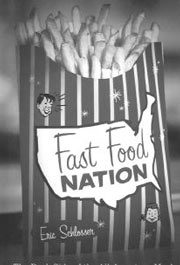WAKE UP, FATTY. Yes, we’re talking to you, lard-ass—or at least journalist Eric Schlosser is, in his polemical article-turned-book based on reporting begun three years ago for Rolling Stone. He intends Fast Food Nation to be an alarm, a call to outrage, indignation, and action as was Upton Sinclair’s 1906 meatpacking industry expos頼I>The Jungle—which he explicitly cites as a model.
Certainly, our artery-clogging, face-stuffing habits are grounds for concern. The term “obesity epidemic” has become front-page news, with the medical community, surgeon general, and Centers for Disease Control and Prevention all decrying our expanding national waistline. (According to the CDC, one in five Americans is considered medically obese.) Schlosser seizes upon the new fat scare, couples it to our perennial anxiety about health, then blames a very different culprit than the one standing on your bathroom scale each morning.
Fast Food Nation
by Eric Schlosser (Houghton Mifflin, $25)
It’s an industrial problem, he argues, and that industry is fast food, a uniquely American success story of entrepreneurs—who benefited from government subsidies—catering to our insatiable appetites. Accordingly, Schlosser salts his book with some startling statistics: Since 1970, the domestic fast-food market has grown from $6 billion to $110 billion. McDonald’s had about 1,000 US restaurants in 1968 and today boasts 28,000 worldwide. (And one in eight Americans has worked for the chain!) From farm to mouth, the markup on an order of French fries measures about 7,500 percent. The average American consumes 56 gallons of soda per year—which is even more profitable—and three burgers a week. Half our national food budget now goes to restaurants (up from a quarter a generation ago), “mainly at fast-food restaurants,” Schlosser asserts.
THE NUMBERS ARE daunting, but Schlosser uses them like a cudgel to attack more than just the Golden Arches. Instead, he takes aim at the entire capitalist enterprise—and with it DC industry lobbyists, Republicans, and those poor, benighted souls who live in the suburbs. To put it bluntly, he’s biting off more than he can chew.
That’s unfortunate because Fast Food Nation‘s better points tend to get obscured by his overreaching and expanding what could’ve been—and presumably was—a good magazine series. Portraits of the pioneering founders of chains, including McDonald’s, Wendy’s, and Carl’s Jr., are strong, depicting self-taught, bootstrapping tycoons who capitalized on our national love of cars, convenience, and cheap food laden with salt, fat, and calories. These tastes coincided with the post-World War II economic boom, the baby boom, and the interstate highway system, Schlosser notes, a period when fast-food franchises also enjoyed federal largesse in the form of loan guarantees.
“What we eat has changed more in the last 40 years than in the previous 40,000,” the author declares before quickly detailing the additives, preservatives, monoculture, chemicals, and assembly-line production techniques that create identical Happy Meals the world over. It’s a disturbing trend, with both big agribusiness cartels and genetic scientists complicit. In its ruthless efficiency, the fast-food industry has a woeful public safety record, evidenced by the E. coli outbreaks of the ’90s. Schlosser is at his most persuasive detailing how Jack in the Box recovered from that crisis by adding only a penny per pound to its beef costs to ensure radically safer meat.
Although it’s poorly organized, packed with filler, and shallowly researched, Nation still carries a wallop. Even by gathering—and acknowledging—other journalists’ work in one tome, Schlosser performs a valuable service. Yet his suggestions for strengthened FDA and OSHA regulations will be futile in George W.’s Washington, and that’s a shame. Worse is how the fast-food industry targets children with its fattening wares—a greater threat to kids than any violent movie. What the book misses, of course, is an honest appraisal of fast-food customers, the ones who willingly, eagerly line up on the other side of the counter. In this unhealthy cycle of supply and demand, surely we bear equal weight.








